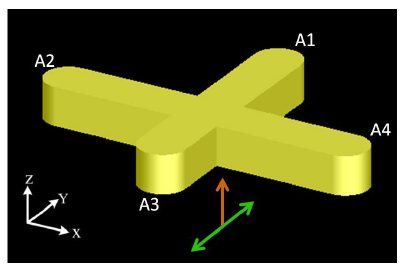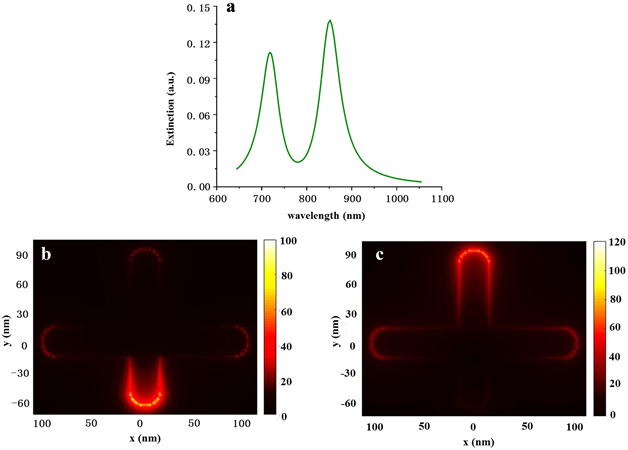Applied Physics
Vol.
09
No.
11
(
2019
), Article ID:
33088
,
7
pages
10.12677/APP.2019.911054
Coherent Control of Spatiotemporal Evolution of the Localized Surface Plasmon Field
Hanbing Song, Jianguo Lei, Boyu Ji, Peng Lang, Jingquan Lin*
Ultrafast Optics Laboratory, Changchun University of Science and Technology, Changchun Jilin

Received: Oct. 30th, 2019; accepted: Nov. 14th, 2019; published: Nov. 21st, 2019

ABSTRACT
Surface plasmons have been used in many research fields for the unique physical properties. At present, coherent control of dynamical evolution of surface plasmons and matter on the micro scale is widely concerned. In this paper, the optical response of asymmetric gold cross nanostructure is simulated when the incident light is monochromatic continuous light, positive chirped pulse and negative chirped pulse, respectively. It is found that when the positive chirped pulse is used, two resonance modes can be generated, and the time evolution law of the plasmon field at different positions of the structure is analyzed. To the negative chirped pulse, the excitation sequence of the two resonant modes is opposite, so the plasmon field can be effectively manipulated. This study is of great significance for the design and optimization of plasmonic nano-devices.
Keywords:Localized Surface Plasmon, Chirped Pulse, Spatiotemporal Evolution, Coherent Control, Finite Difference Time Domain
局域表面等离激元场时空演化的 相干控制
宋寒冰,雷建国,季博宇,郎鹏,林景全*
长春理工大学超快光学实验室,吉林 长春

收稿日期:2019年10月30日;录用日期:2019年11月14日;发布日期:2019年11月21日

摘 要
等离激元具有独特的物理特性,在许多研究领域得到了重要应用。目前,在微观尺度下等离激元与物质作用动力学演化的相干控制,正广受关注。本文分别模拟了入射光为单色连续光、正啁啾脉冲与负啁啾脉冲时,非对称金纳米十字结构的光学响应。发现当采用单色连续光照射时,纳米结构中热点的空间位置具有很好的稳定性,正啁啾脉冲时能够激发产生两种共振模式,并对等离激元场在不同结构位置的时间演化规律进行了分析。当采用负啁啾脉冲时,两种共振模式的激发顺序相反,实现了对等离激元时空演化的有效调控。该研究对于等离激元纳米器件设计和优化具有重要意义。
关键词 :局域等离激元,啁啾脉冲,时空演化,相干控制,时域有限差分

Copyright © 2019 by author(s) and Hans Publishers Inc.
This work is licensed under the Creative Commons Attribution International License (CC BY).
http://creativecommons.org/licenses/by/4.0/


1. 引言
随着科技的不断进步发展,人们对器件小型化以及集成化有了更高的追求,表面等离激元(Surface plasmon, SP)由于其独特的性质,能够突破衍射极限,在纳米尺度上操控光子。在光电子器件、太阳能电池、生物/化学传感器以及光电探测等领域具有极大的应用前景 [1] - [8]。而热点位置的时空调控是等离激元在各个领域中应用的关键因素,因此等离激元的相干控制受到人们广泛的关注 [8] - [16]。在之前的研究中人们发现相位调制能够实现对等离激元时空演化的有效调控,与偏振、波长等其他调控手段相比,相位调制能够在时域上对热点位置进行灵活调控。2002年Stockman首次从理论上研究了相位调制对V形纳米结构近场演化的影响 [17]:仅通过对脉冲的相位调制,可以实现将局域场集中到V形纳米结构的顶点处,证明了相位调制可在纳米系统中实现能量的局域化。随后,Lee T. W.通过FDTD方法的计算表明利用啁啾脉冲的特性可以控制金属表面附近热点的时空行为,产生违反直觉的负群速度 [18]。此外,Harada T.证明了对于具有不同纵横比的Au纳米十字结构,局域等离激元的激发序列可以通过光谱范围很宽的啁啾飞秒激光脉冲和偏振共同来调控 [19]。2016年,Manuilovich对比了入射脉冲为正啁啾脉冲、负啁啾脉冲、与无啁啾脉冲时,锥形结构尖端附近的近场增强,发现具有负初始啁啾的脉冲照射下,尖端附近得到更大的近场增强 [20]。
本文设计了一种利于器件小型化的单一非对称金纳米十字结构,运用时域有限差分软件(FDTD Solutions) [21] 对这种结构进行了模拟研究。对比了入射激光分别为单色连续光,正啁啾脉冲与负啁啾脉冲时,热点位置的时空演化规律,实现了对局域等离激元动力学演化过程的相干控制。我们表明不同入射光激发的等离激元具有不同演化特性,这些不同的演化特性将根据不同应用领域的需求,进行选择性应用。
2. 计算设置
本文采用FDTD Solutions软件对图1所示的非对称金纳米结构进行了模拟研究,该结构由四个金纳米棒组成,其中A1与A3棒沿y轴方向,A2与A4棒沿x轴方向,棒长分别为A1 = 80 nm,A3 = 50 nm,A2 = A4 = 90 nm,在每个棒的顶端,存在半径为15 nm的半圆,每个纳米棒的宽度等于30 nm,沿z轴方向的高度为30 nm。为了方便计算纳米结构的消光谱,入射光采用沿z轴入射,y轴偏振的全场散射场(total field scattered-field, TFSF)光源,如图1所示。在模拟过程中设定纳米结构周围介质为真空环境(n = 1),模拟区域为 ,结构周围的网格精度为 ,选用完美匹配层(PML)作为边界条件。在模拟中含有啁啾的光源无法直接设置,需要通过脚本调制超短激光脉冲相位的方法来实现。

Figure 1. Schematic of the proposed asymmetric gold cross nanostructure: A1 = 80 nm, A3 = 50 nm, A2 = A4 = 90 nm, arm width is 30 nm, and the height is 30 nm. The incident direction is along the z axis and the polarization direction is along the y axis
图1. 非对称金纳米十字结构示意图:A1 = 80 nm,A3 = 50 nm,A2 = A4 = 90 nm,臂宽30 nm,高30 nm。光源从Z轴正方向入射,沿Y轴偏振
3. 结果与讨论

Figure 2. Optical response of the nanostructure illuminated by the monochromatic continuous light. (a) Extinction spectrum of the proposed nanostructure. (b) Near-field distribution of the nanostructure when the incident wavelength is 718 nm and (c) 852 nm
图2. 入射光为单色连续光时,纳米结构的光学响应。(a) 纳米结构的消光谱。(b) 入射波长为718 nm时纳米结构的近场分布图。(c) 入射波长为852 nm时纳米结构的近场分布图
通常情况下,金属表面存在大量自由电子,形成自由电子气团,当入射光与金属纳米结构表面自由电子气团的振动发生共振时就形成了表面等离激元共振(surface plasmon resonance, SPR) [22],当产生SPR时会在光谱上表现为一个强消光峰。本文模拟了入射光沿z轴入射,y轴偏振时,非对称金纳米十字结构的消光谱,如图2(a)所示。消光谱中存在两个峰值,即当入射光沿z轴入射,y轴偏振时,存在两种共振模式,共振波长分别为718 nm和852 nm。当采用波长为718 nm的单色连续光照射纳米结构时,可以激发一种共振模式,近场分布如图2(b)所示,可以看出此时电场主要集中在A3棒顶端。当采用波长为852 nm的单色连续光照射时则激发出另一种共振模式,近场分布图如图2(c)所示,此时电场主要集中在A1棒顶端。研究发现,当采用单色连续光照射时,纳米结构中热点的空间分布始终不变,这表明单色光激发的局域等离激元,热点的空间位置具有很好的稳定性,这一特性使表面等离激元在表面增强拉曼散射(Surface-Enhanced Raman Scattering, SERS)、生物医疗等方面能够进行更有效的应用。

Figure 3. Optical response of the nanostructure when the incident beam is the positive chirped pulse. (a) Schematic diagram of the positive chirped pulse:
,,  , and spectral range is 644 - 1064 nm. (b) Time evolution curve of the localized electric field at A1 bar and A3 bar. (c) Near-field distribution of the nanostructure at time of 148.9 fs and (d) 182.4 fs
, and spectral range is 644 - 1064 nm. (b) Time evolution curve of the localized electric field at A1 bar and A3 bar. (c) Near-field distribution of the nanostructure at time of 148.9 fs and (d) 182.4 fs
图3. 当入射光为正啁啾脉冲时,纳米结构的光学响应。(a) 正啁啾脉冲示意图:
, ,
,光谱范围为644~1064 nm。(b) 正啁啾脉冲条件下,A1棒端点与A3棒端点局域电场的时间演化曲线。(c) 148.9 fs时刻,纳米结构的近场分布图。(d) 182.4 fs时刻,纳米结构的近场分布图
,
,光谱范围为644~1064 nm。(b) 正啁啾脉冲条件下,A1棒端点与A3棒端点局域电场的时间演化曲线。(c) 148.9 fs时刻,纳米结构的近场分布图。(d) 182.4 fs时刻,纳米结构的近场分布图
如图2(b)、图2(c)所示,当采用单色连续光照射纳米结构时,只能激发出一种共振模式的局域等离激元。而当入射光为光谱范围很宽的超短激光脉冲时则可以展现出更加丰富的光学现象。接下来我们研究了入射光为含有啁啾的超短激光脉冲时,局域场的演化特性。
超短激光脉冲的表达式为:
 (1)
(1)
其中 为载波频率, 为高斯包络: ,, 为脉冲持续时间,当脉冲本身含有相位调制或者变换极限脉冲通过色散介质时,会产生啁啾 [23],即不同频率具有不同的相速度,初始相位不再相同,脉冲的瞬时频率随时间的变化而不断变化。在模拟中,我们通过调控超短激光脉冲的相位来实现啁啾光源:
 (2)
(2)
可以通过改变 的符号来控制啁啾脉冲的正负,并且脉冲的功率谱不会随着符号的改变而变化。图3(a)所示为正啁啾脉冲示意图,此时, ,,光谱范围为644~1064 nm,包含了两种模式的共振波长。图3(b)给出了正啁啾脉冲激发时纳米结构A1棒端点与A3棒端点局域电场的时间演化曲线,可以看出A1点先于A3点在148.9 fs时达到了最大近场增强,近场分布图如图3(c)所示,与共振波长为852 nm时的共振模式近场分布一致。A3点在182.4 fs达到了最大近场增强,近场分布图如图3(d)所示,与共振波长为718 nm的共振模式近场分布一致。也就是说当正啁啾脉冲照射时,两种共振模式都被激发,并且共振波长为852 nm的共振模式比共振波长为718 nm的共振模式先被激发。这是因为当正啁啾脉冲入射时,脉冲的瞬时频率随时间而逐渐增大,即波长随时间逐渐减小,当瞬时激光频率与金属纳米颗粒表面自由电子气团的振动频率发生共振时会产生局域表面等离激元共振,此时的近场强度最强,由于852 nm的共振波长先于718 nm的共振波长出现,所以波长为852 nm的共振模式先被激发。

Figure 4. Optical response of the nanostructure when the incident beam is the negative chirped pulse. (a) Schematic diagram of the negative chirped pulse: ,,, and spectral range is 644 - 1064 nm. (b) Time evolution curve of the localized electric field at A1 bar and A3 bar. (c) Near-field distribution of the nanostructure at time of 145.5 fs and (d) 172.0 fs
图4. 当入射光为负啁啾脉冲时,纳米结构的光学响应。(a) 负啁啾脉冲示意图: ,,,光谱范围为644~1064 nm。(b) 负啁啾脉冲激发下,A1棒端点与A3棒端点局域电场的时间演化曲线。(c) 145.5 fs时刻,纳米结构的近场分布图。(d) 172.0 fs时刻,纳米结构的近场分布图
相应地,图4(a)给出了负啁啾脉冲示意图, ,脉冲宽度与中心频率与正啁啾脉冲时一致。A1棒与A3棒端点局域电场的时间演化曲线如图4(b)所示,图4(c)与图4(d)则给出了对应的最大场增强时刻的近场分布图。与正啁啾脉冲的情况相反,共振波长为718 nm的共振模式比共振波长为852 nm的共振模式先被激发。这是因为当负啁啾脉冲入射时,瞬时频率随时间而逐渐减小,即718 nm的共振频率先于852 nm的共振频率出现,所以718 nm的共振模式将先被激发。
啁啾脉冲激发时两种共振模式都能够被激发,并且通过改变啁啾脉冲的正负,能够调控两种共振模式被激发的顺序,可实现对等离激元动力学演化的相干调控。这一特性能够在生物/化学传感器以及光通讯方面得到应用。
4. 结论
本文采用不同条件入射光源对非对称金纳米十字结构进行了模拟分析,得到当采用单色连续光源时,热点的空间位置不随时间而变化,具有很好的稳定性。而啁啾脉冲则能够分别激发两种共振模式,发现热点在不同时间段局域在不同的位置,通过改变啁啾脉冲的符号,可以调控两种共振模式被激发的顺序,实现了局域等离激元在微观尺度下动力学演化的相干调控,且具有很大的灵活性。该研究在SERS、生物医疗、生物/化学传感器以及光通讯等领域具有潜在应用前景。
文章引用
宋寒冰,雷建国,季博宇,郎 鹏,林景全. 局域表面等离激元场时空演化的相干控制
Coherent Control of Spatiotemporal Evolution of the Localized Surface Plasmon Field[J]. 应用物理, 2019, 09(11): 442-448. https://doi.org/10.12677/APP.2019.911054
参考文献
- 1. Jiang, N.-N., Zhuo, X.-L. and Wang, J.-F. (2018) Active Plasmonics: Principles, Structures, and Applications. Chemical Reviews, 118, 3054-3099. https://doi.org/10.1021/acs.chemrev.7b00252
- 2. Joly, A.G., El-Khoury, P.Z. and Hess, W.P. (2018) Spatiotemporal Imaging of Surface Plasmons Using Two-Color Photoemission Electron Microscopy. The Journal of Physical Chemistry C, 122, 20981-20988. https://doi.org/10.1021/acs.jpcc.8b05849
- 3. Joly, A.G., Gong, Y., El-Khoury, P.Z. and Hess, W.P. (2018) Surface Plasmon-Based Pulse Splitter and Polarization Multiplexer. The Journal of Physical Chemistry Letters, 9, 6164-6168. https://doi.org/10.1021/acs.jpclett.8b02643
- 4. Kim, S., Jin, J., Kim, Y.J., et al. (2008) High-Harmonic Generation by Resonant Plasmon Field Enhancement. Nature, 453, 757-760. https://doi.org/10.1038/nature07012
- 5. Abb, M., Wang, Y.-D., De Groot, C.H. and Muskens, O.L. (2014) Hotspot-Mediated Ultrafast Nonlinear Control of Multifrequency Plasmonic Nanoantennas. Nature Communications, 5, 4869. https://doi.org/10.1038/ncomms5869
- 6. Dombi, P., Hörl, A., Rácz, P., et al. (2013) Ultrafast Strong-Field Photoemission from Plasmonic Nanoparticles. Nano Letters, 13, 674-678. https://doi.org/10.1021/nl304365e
- 7. Wagner, M., Fei, Z., McLeod, A.S., et al. (2014) Ultrafast and Nanoscale Plasmonic Phenomena in Exfoliated Graphene Revealed by Infrared Pump-Probe Nanoscopy. Nano Letters, 14, 894-900. https://doi.org/10.1021/nl4042577
- 8. Fang, X., Lun, T.M., Ou, J.-Y., et al. (2014) Ultrafast All-Optical Switching via Coherent Modulation of Metamaterial Absorption. Applied Physics Letters, 104, Article ID: 141102. https://doi.org/10.1063/1.4870635
- 9. Zhou, F., Li, Z.-Y., Liu, Y. and Xia, Y.N. (2008) Quantitative Analysis of Dipole and Quadrupole Excitation in the Surface Plasmon Resonance of Metal Nanoparticles. The Journal of Physical Chemistry C, 112, 20233-20240. https://doi.org/10.1021/jp807075f
- 10. Hrelescu, C., Sau, T.K., Rogach, A.L., et al. (2011) Selective Excitation of Individual Plasmonic Hotspots at the Tips of Single Gold Nanostars. Nano Letters, 11, 402-407. https://doi.org/10.1021/nl103007m
- 11. Awada, C., Popescu, T., Douillard, L., et al. (2012) Selective Excitation of Plasmon Resonances of Single Au Triangles by Polarization-Dependent Light Excitation. The Journal of Physical Chemistry C, 116, 14591-14598. https://doi.org/10.1021/jp303475c
- 12. Koya, A.N., Ji, B.-Y., Hao, Z.-Q. and Lin, J.Q. (2017) Coherent Control of Gap Plasmons of a Complex Nanosystem by Shaping Driving Femtosecond Pulses. Plasmonics, 12, 1693-1699. https://doi.org/10.1007/s11468-016-0435-7
- 13. Bahar, E., Arieli, U. and Suchowski, H. (2019) Coherent Control of the Non-Instantaneous Response of Plasmonic Nanostructes. Applications and Technology, Optical Society of America, CLEO, JTu3M. 3. https://doi.org/10.1364/CLEO_AT.2019.JTu3M.3
- 14. Song, X.-W., Ji, B.-Y., Lang, P., et al. (2018) Subwavelength Imaging and Control of Ultrafast Optical Near Field in Nanosized Bowtie and Ring. Proceedings of Ultrafast Phenomena and Nanophotonics, 22th International Society for Optics and Photonics, 10530, Article ID: 1053018.
- 15. Ichiji, N., Otake, Y. and Kubo, A. (2019) Spectral and Temporal Modulations of Femtosecond SPP Wave Packets Induced by Resonant Transmission/Reflection Interactions with Metal-Insulator-Metal Nanocavities. arXiv Preprint arXiv:1904.11750. https://doi.org/10.1364/OE.27.022582
- 16. Triolo, C., Savasta, S., Settineri, A., et al. (2019) Near-Field Imaging of Surface-Plasmon Vortex-Modes around a Single Elliptical Nanohole in a Gold Film. Scientific Reports, 9, 5320. https://doi.org/10.1038/s41598-019-41781-2
- 17. Stockman, M.I., Faleev, S.V. and Bergman, D.J. (2002) Coherent Control of Femtosecond Energy Localization in Nanosystems. Physical Review Letters, 88, Article ID: 067402. https://doi.org/10.1103/PhysRevLett.88.067402
- 18. Lee, T.W. and Gray, S.K. (2005) Controlled Spatiotemporal Excitation of Metal Nanoparticles with Picosecond Optical Pulses. Physical Review B, 71, Article ID: 035423. https://doi.org/10.1103/PhysRevB.71.035423
- 19. Harada, T., Matsuishi, K., Oishi, Y., et al. (2011) Temporal Control of Local Plasmon Distribution on Au Nanocrosses by Ultra-Broadband Femtosecond Laser Pulses and Its Application for Selective Two-Photon Excitation of Multiple Fluorophores. Optics Express, 19, 13618-13627. https://doi.org/10.1364/OE.19.013618
- 20. Manuilovich, E.S., Astapenko, V.A. and Golovinskii, P.A. (2016) Superfocusing of an Ultrashort Plasmon Pulse by a Conducting Cone. Quantum Electronics, 46, 50. https://doi.org/10.1070/QE2016v046n01ABEH015910
- 21. FDTD Solutions. http://www.lumerical.com
- 22. 李志远, 李家方. 金属纳米结构表面等离子体共振的调控和利用[J]. 科学通报, 2011, 56(32): 2631-2661.
- 23. 张志刚. 飞秒激光技术[M]. 北京: 科学出版社, 2011.
NOTES
*通讯作者。